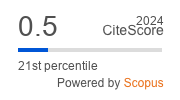Isolated bitemporal hemianopia in a patient with COVID-19
https://doi.org/10.47093/2218-7332.2020.11.2.92-98
Abstract
Introduction. Symptoms of lesions of the I, VII and IX pairs of cranial nerves during SARS-CoV-2 infection are observed in about a third of cases. Isolated bitemporal hemianopia as a symptom of optic nerve damage at the chiasmal level in patients with COVID-19 has not been described yet.
Case report. A 65-year-old man with a history of arterial hypertension and myocardial infarction and confirmed COVID-19 infection with severe lung damage on computed tomography. Patient developed bitemporal hemianopia, confirmed by the Donders test, on the second day of hospitalization. CT scan revealed no lesions and organic pathology in the parachiasmatic region and in the substance of the brain. Two days later, there was a complete restoration of lateral vision.
Discussion. The most likely cause of bitemporal hemianopia was microthrombotic or inflammatory lesion at the chiasmal level. Risk factors for thrombotic complications: male gender, age 65, history of cardiovascular diseases, increased D-dimer levels, and signs of systemic inflammation (increased levels of C-reactive protein, fibrinogen, lactate dehydrogenase, and ferritin). An alternative hypothesis for the development of chiasmal syndrome may be direct viral invasion SARS-CoV-2 of the central nervous system.
Keywords
About the Authors
M. S. ZharkovaRussian Federation
Maria S. Zharkova, MD, PhD, Head of hepatology department, V. Vasilenko Clinic of Internal Diseases Propaedeutics, Gastroenterology and Hepatology, University Clinical Hospital No. 2
8/2, Trubetskaya str., Moscow, 119991
I. N. Tikhonov
Russian Federation
Igor N. Tikhonov, Assistant Professor, Department of Internal Disease Propedeutics; gastroenterologist of hepatology department, V. Vasilenko Clinic of Internal Diseases Propaedeutics, Gastroenterology and Hepatology, University Clinical Hospital No. 2
8/2, Trubetskaya str., Moscow, 119991
+7 (917) 542-08-86
I. V. Efremova
Russian Federation
Irina V. Efremova, postgraduate student, Department of Internal Disease Propedeutics
8/2, Trubetskaya str., Moscow, 119991
S. A. Ondos
Russian Federation
Shauki А. Ondos, MD, PhD, gastroenterologist of hepatology department, V. Vasilenko Clinic of Internal Diseases Propaedeutics, Gastroenterology and Hepatology, University Clinical Hospital No. 2
8/2, Trubetskaya str., Moscow, 119991
M. Yu. Nadinskaia
Russian Federation
Maria Yu. Nadinskaia, MD, PhD, Associate Professor, Department of Internal Disease Propedeutics
8/2, Trubetskaya str., Moscow, 119991
V. T. Ivashkin
Russian Federation
Vladimir T. Ivashkin, MD, PhD, DMSc, Professor, Academician of the RAS, Head of Department of Internal Diseases Propedeutics; Director of V. Vasilenko Clinic of Internal Diseases Propaedeutics, Gastroenterology and Hepatology, University Clinical Hospital No. 2
8/2, Trubetskaya str., Moscow, 119991
References
1. Peli E., Satgunam P. Bitemporal hemianopia; its unique binocular complexities and a novel remedy. Ophthalmic Physiol Opt. 2014; 34(2): 233–42. https://doi.org/10.1111/opo.12118 PMID: 24588535
2. Ministerstvo zdravookhraneniya. Vremennye metodicheskie rekomendatsii. «Profilaktika, diagnostika i lechenie novoi koronavirusnoi infektsii (COVID-19)». Versiya 7. [Contemporary clinical guidelines for prevention, diagnosis and treating novel coronavirus infection COVID-19, 7-th edition]. 2020. 166 p. (In Russian). URL: https://static-0.rosminzdrav.ru/system/attachments/attaches/000/050/584/original/03062020_%D0%9CR_ COVID-19_v7.pdf (accessed 03.06.2020).
3. Ping W., Fang D., Chunhua L., et al. Characteristics of ocular findings of patients with coronavirus disease 2019 (COVID-19) in Hubei Province, China. JAMA Ophthalmol. 2020; 138(5): 575– 8. https://doi.org/10.1001/jamaophthalmol.2020.1291 PMID: 32232433
4. Guan W., Ni Z., Hu Yu., et al. Clinical Characteristics of Coronavirus Disease 2019 in China. N Engl J Med 2020; 382: 1708–20. https://doi.org/10.1056/NEJMoa2002032 PMID: 32109013
5. Carter C.L., Do D.V. Hydroxychloroquine-induced retinal toxicity. J Rheum. April 2020; 47(4): 632. https://doi.org/10.3899/ jrheum.190538 PMID: 32238544
6. Meng X., Deng Y., Dai Z., Meng Z. COVID-19 and anosmia: Areview based on up-to-date knowledge. Am J Otolaryngol. 2020; 41(5): 10258. https://doi.org/10.1016/j.amjoto.2020.102581 PMID: 32563019
7. Pascual-Goñi E., Fortea J., Martínez-Domeño A., et al. COVID19-associated ophthalmoparesis and hypothalamic involvement. Neurol Neuroimmunol Neuroinflamm. 2020; 25; 7(5): e823. https://doi.org/10.1212/NXI.0000000000000823 PMID: 32587102
8. Kogan E. A., Berezovskii Yu. S., Protsenko D. D., et al. Patologicheskaya anatomiya infektsii, vyzvannoĬ SARS-CoV-2. [Pathological anatomy of infection caused by SARS-CoV-2] 2020; 6(2): 8–30. Sudebnaya meditsina (In Russian). https://doi. org/10.19048/2411-8729-2020-6-2-8-30
9. Purvin V., Herr G.J., De Myer W. Chiasmal neuritis as a complication of Epstein-Barr virus infection. ArchNeurol. 1988; 45(4): 458–60. https://doi.org/10.1001/archneur.1988.00520280112026 PMID: 2833208
10. Pershing S., Dunn J., Khan A., Liao Y.J. Cytomegalovirus infection with MRI signal abnormalities affecting the optic nerves, optic chiasm, and optic tracts. J Neuroophthalmol. 2009; 29(3): 223–6. https://doi.org/10.1097/WNO.0b013e3181b4a245 PMID: 19726946
11. Irioka T., Akaza M., Nakao K., et al. Chiasmal optic neuritis following mumps parotitis. J Neurol. 2008; 255(5): 773–4. https://doi.org/10.1007/s00415-008-0810-1 PMID: 18286315







































